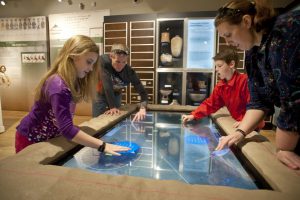
Florida Museum of Natural History photo by Kristen Grace
GAINESVILLE, Fla. — Florida Museum of Natural History visitors will have the opportunity Saturday to participate in free opening day activities celebrating the museum’s new featured exhibit, “First Colony: Our Spanish Origins.”
The celebration scheduled from 10 a.m. to 3 p.m. features hands-on activities, interactive displays, information from outside groups and a special presentation by Kathleen Deagan, Florida Museum distinguished research curator emerita.
Deagan, who has conducted fieldwork in St. Augustine, Florida, since 1972, will discuss what she and other scientists have learned about American history from the first Spanish sites.
“Archaeology in the Spanish settlement has helped change our understanding of America’s colonial origins,” said Deagan, who also is a University of Florida adjunct professor emerita of anthropology, history and Latin American studies. “Our first permanent colony was established 42 years before Jamestown. The artifacts and material remains left in the ground by the early Spanish colonists reveal a very different and more culturally diverse lifestyle from that found in the English colonies.”
Through archaeology, interactive activities and more than 400 artifacts, the “First Colony” exhibit reveals the history and real stories of the people who crafted St. Augustine in 1565.
Opening day children’s activities include mapping food origins to learn how cultures have mingled, constructing a model town based on Spanish law, stamping clay to illustrate how Timucuans made pottery and weaving a “God’s eye,” a symbol of protection used by some indigenous people.
“We’re looking forward to having fun and learning about archaeology, multiculturism and how Florida rocks in American history,” said Florida Museum public programs coordinator Catherine Carey.
While opening day activities are free, admission to the “First Colony” exhibit is $6.50 for adults ($6 for seniors, Florida residents and college students); $4.50 for ages 3-17; and free for Florida Museum members and UF students with a valid Gator 1 card.
The Florida Museum will display the exhibit through April 17, 2016.
“First Colony: Our Spanish Origins” was produced by the Florida Museum of Natural History and University of Florida Historic St. Augustine Inc., and sponsored in part by the Department of State, Division of Historical Resources and the State of Florida.
For more information, visit www.floridamuseum.ufl.edu/firstcolony/home.
-30-
Writer: Maria Espinoza, PRintern@flmnh.ufl.edu
Source: Catherine Carey, ccarey@flmnh.ufl.edu
Media contact: Paul Ramey, 352-273-2054, pramey@flmnh.ufl.edu